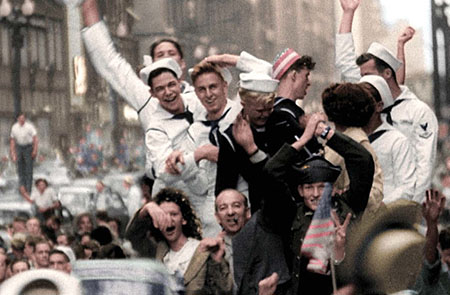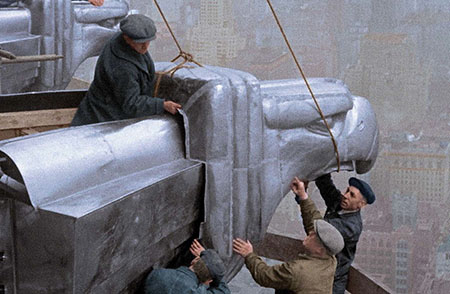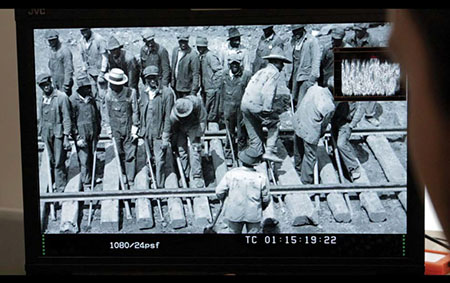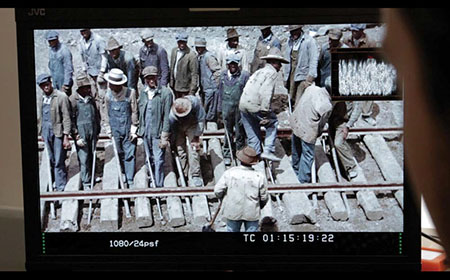Colorizing History
WASHINGTON—The invention and implementation of motion pictures in the late 19th and early 20th centuries helped capture some of the most important events in American history. Footage of Babe Ruth swatting a home run, the celebration of VE and VJ Day, and Martin Luther King on the steps of the Lincoln Memorial is burned into our memories. When we think about them though, it is almost certainly in black and white.

Americans celebrate at the end of World War II
PHOTO CREDIT: Smithsonian Channel
For the first 60 so years of the 20th century, black and white was essentially the defacto medium for capturing our daily lives, with color being an expensive, rare luxury. As a result, colorized versions of some historical events aren’t readily available. But not anymore.
The Smithsonian Channel has released a new series that tells the stories of the 1920s through the 1960s as they happened—in color. Featuring restored footage from archives to home movies, “America in Color” was a year in the making production of five episodes tackling each decade.
“This is the way that people lived it and experienced it,” said John Cavanagh, executive producer of “America in Color,” which debuted on July 2.
THE COLOR PALETTE
The process of colorization has been around essentially as long as film has. One of the most famous colorized films is “The Great Train Robbery” in 1903, when individual frames were literally painted. Things have changed a lot since then.
To take on the endeavor of updating the 200 minutes of black and white footage, comprised of around 3,500 individual shots, for “America in Color,” Smithsonian Channel turned to Samuel François-Steininger and his company Composite Films in Paris. Specializing in restoration and colorization, Composite Films has worked on a number of historical film and TV documentaries, including the Oscar-nominated doc “I Am Not Your Negro.”
Get the TV Tech Newsletter
The professional video industry's #1 source for news, trends and product and tech information. Sign up below.

Construction of the Chrysler Building
PHOTO CREDIT: Smithsonian Channel
The first step in the process after acquiring and editing the footage together was scanning it to convert it to UHD resolution, something that has only recently been available. Composite also handled the restoration of any footage that might be damaged, utilizing gear like the DaVinci Revival from Blackmagic Design to remove moisture, dirt and other artifacts that might have affected the film over time. “Like bringing a new life in black and white,” François-Steininger said of the process.
Once restored, colorization began. There was more to the process, however, than simply adding in the color. The Composite team was comprised of researchers, archivists and investigators who were responsible for determining the appropriate colors to be used on each shot. Some sequences had historical reference to determine the color—like when the Wheaties box went from a dark maroon shade to its now familiar orange—but in instances were civilians were present, things became more difficult.
“It’s a mix between analysis of the black and white information, so we know what range, what tone of color it could and couldn’t be, which gives us the first information,” François-Steininger explained. “Also the second step, which is more deduction because we know the year, the city, the brand of the car, or the kind of clothes. Finding the fashion of the particular era… this designer or this brand of car... we can do some crossing deduction, which are results of this investigation, to find not 100 percent sure color, but we are quite close to what it might have been.”
Once colors are determined, François- Steininger and Composite do not rely on a single commercial product, but rather a combination of software from Adobe PhotoShop, DaVinci Resolve and more. Using these techniques, the team would spend perhaps a few hours on a five second shot that just involved two people, or could spend as much as weeks for a 30-second shot of Charles Lindbergh’s ticker-tape parade in New York City. In total, an estimated 6,000 hours of work was put into the colorization of these episodes.
HISTORICAL CONTEXT
More than 30 years ago there was an even larger undertaking on colorization going on, as Ted Turner controversially attempted to colorize classic Hollywood films that he held the rights to for broadcast on television. Some of the titles Turner attempted to bring to color included “The Maltese Falcon,” “Casablanca” and “The Postman Always Rings Twice,” among others.
“The last time I checked, I owned the films that we’re in the process of coloring,” Turner was quoted in a Los Angeles Times article in 1986. “I can do whatever I want with them, and if they’re going to be shown on television, they’re going to be in color.”


Composite Films used a combination of software programs, including the DaVinci Resolve and Photoshop, to handle the colorization.
(Photo credit: screenshots from a video by Etienne Semelet / Composite Films)
This did not sit well with many. Filmmakers like Woody Allen, Billy Wilder and Sydney Pollack vehemently protested—including to Congress—about the colorization of these films. While some did air on Turner��s stations, eventually the opposition won out and the colorized films are more or less hidden from view.
So what is different about the attempts of “America in Color” to convert these historical documents? Cavanagh sees it as an editorial decision, not a business one.
“Colorizing these documentary images brings out the details of everyday life they captured—green New York City buses in the 1920s, the navy blue of a 1930’s Pullman Porter uniform, or the color of FDR’s lapel pin—in a way that enriches and transforms a past that often seems gray and distant into something more immediate, and presents these iconic moments of the 20th century in a new light,” he said.
François-Steininger believes that historians who shot the original films in “America in Color” would have done so in color if they could, so he sees it as fulfillment of their original vision. “Colorizing this footage is more like bringing back its color to history, thanks to the art direction, historical research and technology,” he said. Fictional films, however, had a different purpose. “It’s a work of art. And the creators of the original films might not like seeing them redesigned in color.”
He doesn’t outright reject the idea though. He is currently colorizing a couple of black and white films from the 1960s and 1970s with the blessing of the director and has an interest in doing more. “I would love to colorize some genre films/cult films or classic TV series, where color could really bring an essential new dimension to the story.”
